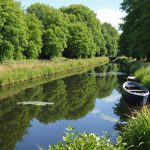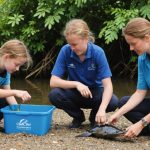Mastering Wildlife Encounters: Training Your Cockapoo for Safe Interactions in UK Parks
Understanding the Importance of Training
When you decide to bring a new puppy, such as a Cockapoo, into your family, one of the first things you should consider is how to ensure their safety and the safety of others, especially in public spaces like UK parks. These areas are often teeming with wildlife, from birds and squirrels to larger animals like deer and foxes. Proper training is crucial to prevent unwanted interactions that could be harmful to both your dog and the wildlife.
"Training your dog is not just about obedience; it's about creating a safe and respectful environment for everyone," says Dr. Emma Taylor, a veterinarian and animal behaviorist. "In the UK, where parks are a common place for dog walking, it's essential to teach your dog how to interact safely with wildlife."
Dans le meme genre : How to Effectively Deter Badgers from Wreaking Havoc in Your Garden?
Choosing the Right Training Methods
Puppy Training Basics
Before diving into specific training for wildlife encounters, it's important to establish a solid foundation of basic obedience skills. Here are some key areas to focus on:
- Toilet Training: Ensuring your puppy knows where to go and when is vital. A well-trained puppy is less likely to get distracted by wildlife.
- Crate Training: This helps with potty training and can also serve as a safe space for your puppy when you're out.
- Lead Walking: Teaching your puppy to walk on a lead without pulling is crucial for controlled walks in parks.
- Basic Commands: Commands like "sit," "stay," and "come" are essential for maintaining control over your dog in various situations.
Breed Specific Considerations
Cockapoos, being a cross between a Cocker Spaniel and a Poodle, are known for their friendly and curious nature. However, they can also be prone to chasing small animals due to their hunting instincts.
Lire également : Is a Standard Tropical Aquarium Ideal for Your Pet Axolotl?
"A Cockapoo's natural instinct to chase can be managed with proper training," advises Sarah Johnson, a dog trainer specializing in breed-specific training. "Early socialization and consistent training can help curb this instinct."
Creating a Week Training Schedule
To ensure your puppy is well-prepared for park visits, you need a structured training schedule. Here’s a sample week-long training plan:
| Day | Morning Session | Afternoon Session |
|---|---|---|
| Monday | Basic Obedience (Sit, Stay, Come) | Lead Walking Practice |
| Tuesday | Socialization (People and Dogs) | Crate Training |
| Wednesday | Toilet Training | Playtime (Controlled Environment) |
| Thursday | Desensitization to Noises | Practice Recall in Distractions |
| Friday | Practice Walking Near Wildlife (Simulated) | Reinforce Basic Commands |
| Saturday | Outdoor Walk with Controlled Interactions | Play and Socialization |
| Sunday | Review and Practice All Commands | Long Walk with Minimal Distractions |
Teaching Your Dog to Interact Safely with Wildlife
Desensitization and Counterconditioning
Desensitization involves gradually exposing your dog to the stimuli that might trigger a reaction (like seeing a squirrel), while counterconditioning involves associating these stimuli with positive outcomes.
- Start with Visual Exposure: Begin by letting your dog see wildlife from a distance, rewarding calm behavior.
- Gradually Increase Proximity: Over time, bring your dog closer to the wildlife while maintaining a calm demeanor.
- Use Positive Reinforcement: Reward your dog with treats and praise for remaining calm.
Practice in Controlled Environments
Before taking your dog to a park, practice in controlled environments like your backyard or a quiet area with minimal distractions.
- Use Mock Scenarios: Use toys or friends to mimic wildlife, teaching your dog to remain calm.
- Reinforce Commands: Ensure your dog responds promptly to commands like "leave it" or "come."
Managing Encounters in UK Parks
Preparing for the Unexpected
Even with thorough training, unexpected encounters can happen. Here are some tips to manage such situations:
- Keep Your Dog on a Lead: Especially in areas known to have wildlife, keeping your dog on a lead can prevent unwanted chases.
- Be Aware of Your Surroundings: Keep an eye out for wildlife and be prepared to intervene if necessary.
- Use Verbal Commands: If your dog starts to chase, use a firm but calm voice to recall them.
Practical Insights and Actionable Advice
Here are some practical tips and advice from experienced dog owners and trainers:
- "Make sure to let your dog sniff and explore but always keep them within sight. This helps them feel secure and reduces the likelihood of them chasing after wildlife," advises Mark Davis, an experienced dog owner.
- "If you encounter wildlife, stay calm and slowly back away. Avoid sudden movements that might provoke a chase," suggests Jane Smith, a park ranger.
Overcoming Common Challenges
Puppy Adolescence and Training
As your puppy grows into adolescence, they may become more energetic and less focused. Here’s how to handle this phase:
- Increase Physical Activity: Adolescents need more exercise to burn off energy.
- Reinforce Training: Consistently reinforce basic commands and behaviors.
- Be Patient: Adolescence can be a challenging phase, so patience and consistency are key.
Dealing with Distractions
Parks can be full of distractions, from other dogs to children playing. Here’s how to keep your dog focused:
- Use High-Value Rewards: In distracting environments, use high-value treats to keep your dog's attention.
- Practice Regularly: The more you practice in different environments, the better your dog will become at ignoring distractions.
Training your Cockapoo for safe interactions in UK parks is a multifaceted process that requires patience, consistency, and the right strategies. By focusing on basic obedience, desensitization, and practice in controlled environments, you can help your dog navigate park visits safely and enjoyably.
"Training is a journey, not a destination," says Dr. Taylor. "With the right approach, you can help your dog become a well-behaved and respectful companion in any environment."
Here is a detailed bullet point list summarizing the key points:
- Establish Basic Obedience: Teach commands like "sit," "stay," and "come."
- Use Breed-Specific Training: Consider the natural instincts of your Cockapoo.
- Create a Structured Training Schedule: Plan out your week with specific training sessions.
- Desensitize and Countercondition: Gradually expose your dog to wildlife stimuli.
- Practice in Controlled Environments: Use mock scenarios and controlled areas before park visits.
- Manage Encounters: Keep your dog on a lead, be aware of surroundings, and use verbal commands.
- Overcome Common Challenges: Increase physical activity during adolescence and use high-value rewards in distracting environments.
By following these guidelines and staying committed to your training schedule, you can ensure that both your dog and the wildlife in UK parks remain safe and happy.











